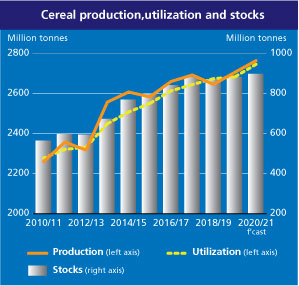FAO lowered its forecast for world cereal production in 2020 by 25.0 million tonnes (0.9 percent) compared to the previous forecast in July. Notwithstanding this downturn in prospects, the expected global cereal output still stands at 2 765 million tonnes, an all-time high and 58 million tonnes above the 2019 outturn.
This month’s production cutback results from a reduction in the world coarse grains forecast, now pegged at 1 496 million tonnes, down 23.5 million tonnes from the previous report in July.
Maize
The bulk of the decline relates to a 26.3 million tonne downward revision to the maize production forecast in the United States of America (USA), where plantings, albeit still up year-on-year, are lower than earlier expectations and recent storm damage in the Midwest caused crop losses and impaired yield prospects.
Overall, however, yields are still expected to recover from the previous year’s low level and the country’s output is forecast at 380 million tonnes, 10 percent higher than in 2019. Production forecasts were also lowered in the European Union (EU) and Ukraine, due to adverse weather that diminished yield prospects, and in Indonesia, where the historical production estimates as well as the 2020 forecast were revised downwards in line with recently released official statistics. These reductions more than offset upward revisions to the maize production forecasts in Argentina and Brazil, with both countries expecting record-high harvests.
Bareley
The forecast for global barley production in 2020 has been trimmed by 1.2 million tonnes, driven by lower yield prospects in the EU, and now stands at 154.2 million tonnes.
Sorghum
By contrast, world sorghum production is now expected to reach nearly 60 million tonnes, 6 percent higher than the previous year, following increased forecasts for India, Mexico and the USA.
Wheat
Global wheat production has been reduced by 1.4 million tonnes since July, which puts this year’s output at 760.1 million tonnes, marginally below the good outturn of 2019. The recent decrease is mostly the result of cuts to production forecasts in Argentina, the EU and the USA by 1.3 million, 4.0 million, and 1.1 million tonnes, respectively, which outweighed upward revisions for Brazil, Canada, the Russian Federation, and Ukraine.
Rice
Small area-based increases to July forecasts of rice production in Colombia, the Philippines and the USA compensated for more downbeat expectations of output in the Lao People’s Democratic Republic and Viet Nam. As a result, global rice production in 2020 is still projected at an all-time high of 509 million tonnes (milled basis), up 1.7 percent from the 2019 reduced level.
Source: FAO’s Cereal Supply and Demand Brief








